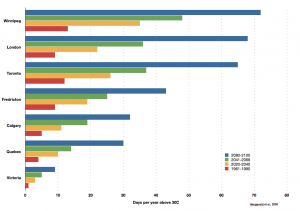 Climate change scenarios predict longer, hotter summers across the Prairie Provinces. Spring would arrive earlier, summer would last longer and heat waves would be more common. Living in Manitoba, more heat might seem like good thing! However, long, uninterrupted heat waves produce dangerous conditions, especially in cities.
Climate change scenarios predict longer, hotter summers across the Prairie Provinces. Spring would arrive earlier, summer would last longer and heat waves would be more common. Living in Manitoba, more heat might seem like good thing! However, long, uninterrupted heat waves produce dangerous conditions, especially in cities.
On this page, we deal with these issues related to extreme heat and health:
- More heat waves
- Urban heat islands
- A windless city?
- No relief at night
- People at risk
- Medication and extreme heat
Click a topic to jump to that location on this page.
More heat waves
A heat wave is a period of abnormally and uncomfortably hot weather with more than three consecutive days of maximum temperature at or above 32°C (1). They are more difficult to bear for city dwellers because the very materials and design of urban architecture trap heat (2).
When carbon dioxide levels in our atmosphere double as predicted, Winnipeg can expect almost 40 days every summer with temperatures above 30°C by mid-century (3). Figure 1 shows how this would be over triple the number of average hot days of summers between 1951 and 1980 (4).
Urban heat islands
Natural landscape features – such as trees – reflect heat and actively cool the air by evapotranspiration. In urban areas, they have been replaced by buildings and paved surfaces. The brick and concrete that that make up much of a city’s surface have high heat conductivity and storage capacities (5). Solar radiation is stored in these materials as heat (6). This produces the urban heat island effect.
Daytime differences between rural and urban temperatures can range as much as 7°C. A pleasantly hot 29°C day in Winkler or Dauphin would be a wilting 36°C in Winnipeg.
A windless city?
Another factor that keeps cities cooking is the lack of wind. Ventilation – the movement of air – is necessary for both convective and evaporative cooling.
The annual mean wind speed at street level is about 35% less than at airport sites in suburban or rural areas (7). The variety and density of multi-storey office buildings, apartment blocks and shopping malls act as giant wind barriers. As a result, urban air remains stagnant and continues to gather heat.
No relief at night
Hot days do not pose the most serious threat to Manitoban urbanites. It is the lack of relief at night that puts people in serious danger (8).
Heat trapped in concrete building and streets is released at night. City temperatures stay uncomfortably high and potentially deadly even when the sun goes down. Without nighttime relief, the human body can succumb to the stresses of intense heat.
Among all natural hazards, including lightning strikes, tornados, floods and earthquakes, prolonged periods of extreme heat produce the highest death tolls in cities (9)
People at risk
 Elderly people are particularly susceptible to heat stress (10). Prolonged exposure to extreme heat strains the heart, which must beat faster and more forcefully to maintain blood flow to the capillaries. The risk of cardiovascular mortality for people older than 64 years, of both sexes and all races increases significantly during heat waves (11).
Elderly people are particularly susceptible to heat stress (10). Prolonged exposure to extreme heat strains the heart, which must beat faster and more forcefully to maintain blood flow to the capillaries. The risk of cardiovascular mortality for people older than 64 years, of both sexes and all races increases significantly during heat waves (11).
In the next twenty years, over 35% of our province’s population will be over 64 years of age (12). One third of Manitobans are at greater risk for heat-related injury and death if the effects of climate change are not properly mediated.
Other people at risk include:
- small children,
- chronic invalids
- individuals who are obese
- those with alcohol problems (13).
Once someone has suffered from heat stroke even once, they are more susceptible to heat-related illnesses in the future (14).
Medication and extreme heat
Treatments for common medical problems may pose a threat during heat waves. Medications such as tranquilizers and anticholinergics suppress sweat gland activity, compromising the body’s ability to cool itself. (15). Anticholinergic drugs encompass a broad family of important medications. They include antihistamines, tricyclic antidepressants, antipsychotics, antiparkinsonians and drugs for intestinal problems.





